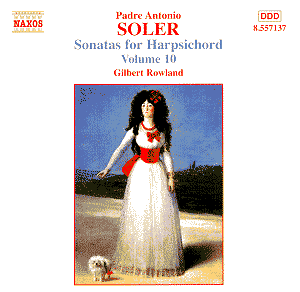Antonio Soler - or
Antonio Francisco Javier José
Soler Ramos, as his full name is - has
been connected with two of the most
prestigious centres of musical activity
in Spain. He received his first musical
education in the monastery of Montserrat,
where he entered the choir school at
the age of six. He studied organ and
composition and seems to have been a
brilliant student.
In the late 1750s he
was appointed chapel master at the Escorial,
the monastery founded by Philip II in
1563, which in Soler's time was an internationally
renowned centre of culture, regularly
visited by the members of the Spanish
court.
Music making at the
Escorial was rich and varied. Not only
religious music, but also theatre and
chamber music was performed. It was
Soler's duty to compose music in all
these genres.
Soler was also very
interested in science and musical history,
and he wrote books on several subjects.
He must have had a
very busy life. Apart from composing
and performing music he had to fulfil
his duties as a monk, and he had to
teach his patron, Infante don Gabriel,
the keyboard.
Today Soler is mainly
known for his keyboard sonatas, none
of which have survived in his own handwriting,
and only 27 of which were printed in
his lifetime.
As a keyboard player
Soler was a pupil of Domenico Scarlatti.
His own sonatas show the influence of
his teacher. Like many of Scarlatti's
sonatas some of Soler's form pairs.
A large number have only one movement,
but at later stages in his life Soler
composed also sonatas in two (Rubio
126), three (Rubio 64) or four (Rubio
61) movements. This shows the influence
of the rococo and the emerging classical
period. Another sign of this influence
is the use of uncommon keys like D flat.
And whereas most of Scarlatti's sonatas
are written in fast tempi Soler frequently
prescribes tempi like 'andante', 'andantino'
or uses the characterisation of 'cantabile'.
Gilbert Rowland has
recorded many of Domenico Scarlatti's
sonatas in the past, so it was only
a logical step to start a complete recording
of the sonatas of Antonio Soler. The
present disc is the 10th in the series.
This is the first and only volume of
the series I have heard, and having
listened to it I don't think I like
to hear the rest.
This indicates that
I am quite disappointed by this recording.
I wouldn’t advise anyone to listen to
this kind of sonatas for an hour at
a stretch, no matter who is playing
them. But Gilbert Rowland doesn’t make
it any easier to do so: listening to
this recording was a very tiring experience.
First of all I don't
like the harpsichord played here: an
unspecified Flemish instrument. This
is a strange choice for Spanish music
anyway, but the sound of the instrument
is pretty sharp and obtrusive. In particular
listening with headphones is painful
to the ears.
But it is also the
playing of Gilbert Rowland which is
rather painful. His relentless hammering
on the harpsichord, with very little
differentiation and variation, and no
breathing spaces or holding back at
key points in the musical structure
makes listening to this recording an
unpleasant adventure. The "drive, brilliance
and technical virtuosity" - as Rowland
in his liner notes describes the character
of the Sonata in D flat (Rubio 88) -
is underlined at the cost of the musical
ideas Soler's sonatas contain. And although
he characterises the first movement
(Pastorale) of the Sonata in G (Rubio
64) as "a piece of considerable charm",
I haven't heard much charm in his performance.
And some uncommon harmonies aren't given
the attention they require.
I am eagerly awaiting
a complete recording of Soler's sonatas
on the appropriate instruments, meaning
first and foremost a Spanish harpsichord.
But some could also be played on other
keyboard instruments, like the clavichord
or the organ, and even the 'modern'
fortepiano.
Johan van Veen
see also review
by Aline
Nassif who was more impressed


